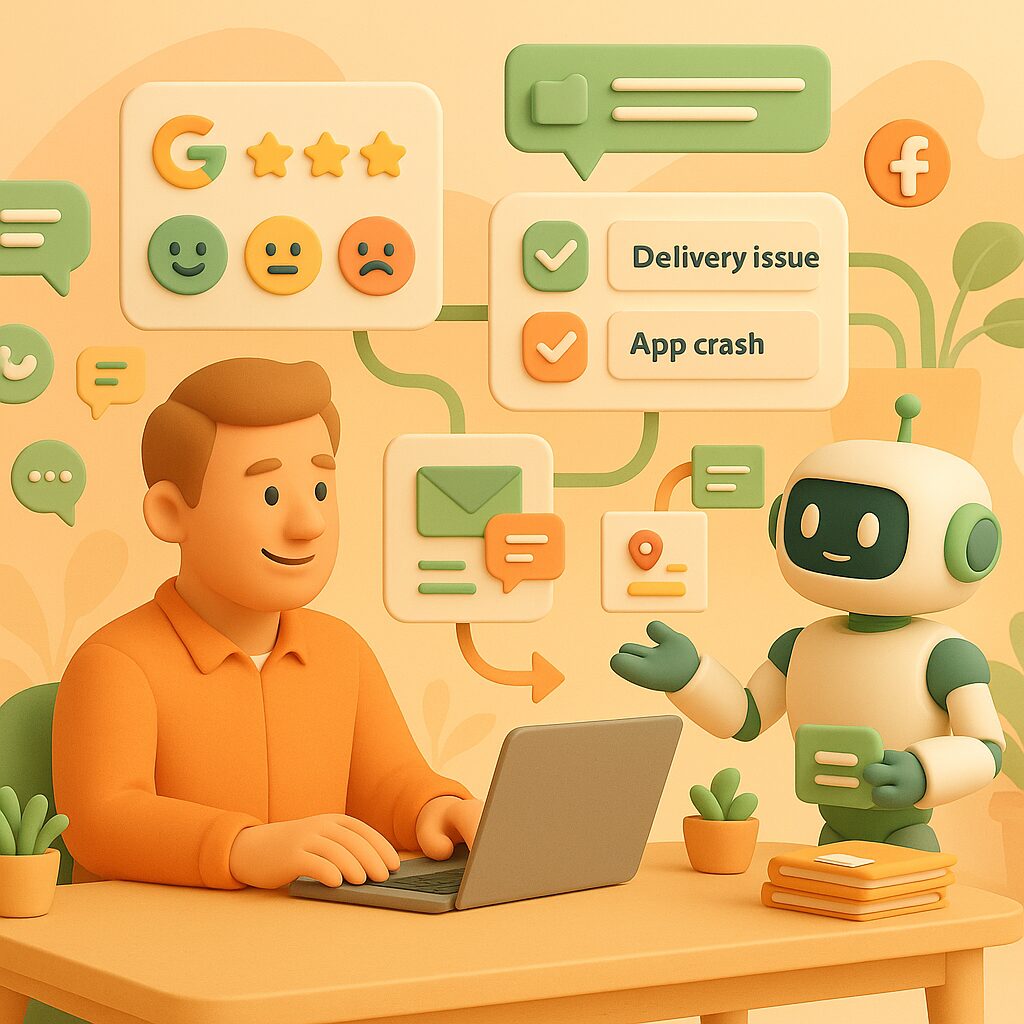Customer feedback used to be simple. You’d read a few emails or respond to a Google review. However, today, small businesses receive feedback from every direction—through surveys, live chats, support tickets, social media posts, and online reviews.
And it all matters. Feedback directly impacts customer experience, online reputation, and retention.
The challenge? Most businesses are overwhelmed by the volume. They have the data but don’t know what to do with it.
That’s where AI-powered customer feedback systems—especially those using vertical AI agents—come in. These intelligent tools do more than collect feedback. They clean it, understand it, and help your team take action fast.
Let’s break down how vertical AI agents power modern feedback systems and why they’re changing how small businesses listen to customers.
What Is a Vertical AI Agent?
A vertical AI agent is an AI system built for a specific industry. That means it’s trained to understand the feedback and operations of businesses like yours—whether you run a dental office, an HVAC company, a legal practice, or a SaaS startup.
Unlike general AI tools, vertical AI agents can make context-aware decisions and prioritize tasks based on what matters most to your type of business.
How AI-Powered Customer Feedback Systems Work
Here’s a step-by-step breakdown of how vertical AI agents transform raw feedback into smart actions.
1. Pulling Feedback from Every Channel
The AI agent gathers feedback from Google reviews, chat logs, support tickets, survey forms, emails, and even social media mentions.
Example:
A Texas-based ecommerce business receives reviews on Shopify, complaints on Twitter, and emails via Zendesk. The AI combines all of it into a single, unified feedback dashboard.
2. Cleaning and Standardizing the Data
AI removes noise like duplicate messages, spam, broken formatting, or emoji overload. It can also translate content from multiple languages and convert everything into a format ready for analysis.
Example:
A bilingual fitness app gets reviews in Spanish and English. The AI instantly translates, tags, and standardizes each comment for analysis.
3. Understanding What Customers Are Saying
Using natural language processing (NLP), the system detects:
Sentiment: Is it a complaint, praise, or neutral?
Intent: Does the user want help, is it a feature request, or are they venting?
Topics: What part of the service are they talking about—pricing, delivery, support?
Entities: Specific product names or issue types
Example:
A customer writes, “The new app update crashes every time I try to check out.”
The AI logs it as a negative review, a complaint, and tags the checkout feature for escalation.
4. Identifying Trends and Taking Action
Once the AI sees patterns, it can:
Notify your team
Open a support ticket
Create a bug report
Draft a response for customer service
Example:
A healthcare scheduling app gets 20 reviews about missed appointments. The AI matches this to a recent backend update and triggers a dev team alert.
5. Recommending Fixes and Sending Follow-Ups
The AI doesn’t stop at analysis. It helps you take the next step by:
Generating reports
Assigning tasks to internal teams
Suggesting customer replies
Highlighting top issues weekly
Example:
A Denver-based SaaS platform sees multiple NPS survey responses complaining about onboarding. The AI recommends improving onboarding flows and suggests new email copy for follow-ups.
6. Learning and Improving Over Time
The system learns from every interaction. If your support team updates the tone of replies or reclassifies a bug, the AI remembers. This makes its recommendations more accurate going forward.
Example:
A law firm notices that clients keep mislabeling a support issue. The AI updates its tagging logic after human corrections and gets more accurate in future cases.
What Makes Vertical AI Feedback Systems Unique?
Traditional feedback tools stop at showing trends. Vertical AI agents do something with the data. They offer:
Context-aware analysis
Automated decision-making
Custom workflows based on your industry
A feedback loop that constantly improves
This makes them perfect for small business service providers who don’t have time to sort through endless spreadsheets or hire a data science team.
Key Features to Look For
If you’re considering a customer feedback system with AI, make sure it includes:
Real-time sentiment tracking
Omnichannel feedback collection
Smart tagging and topic detection
Predictive alerts for recurring issues
Dashboards with actionable insights
Auto-generated reports and response drafts
Custom feedback routing for internal teams
What You Can Do with These Insights
Great feedback systems don’t just give you data. They help you take smarter actions like:
Improving customer service scripts
Fixing specific UX problems
Prioritizing new features or updates
Reducing churn from dissatisfied customers
Identifying upsell and referral opportunities
Final Thoughts
If you’re still managing feedback manually or only responding to reviews when you have time, you’re missing out. AI-powered customer feedback systems are built to keep up with today’s customer expectations.
And if you want something that works for your business—not just in general—look into vertical AI agents. These tools understand your industry, your customers, and your goals.
They don’t just help you listen. They help you respond, improve, and grow.





